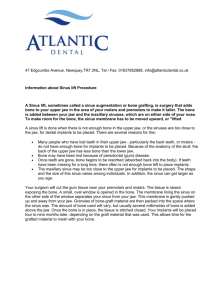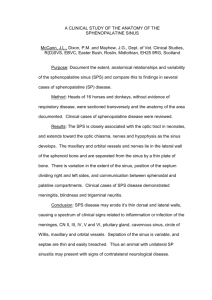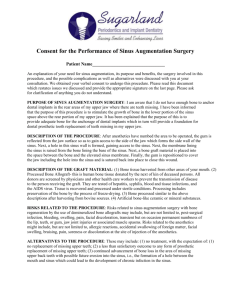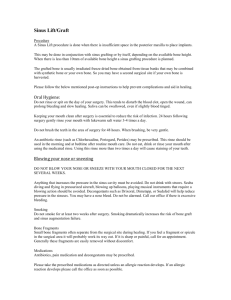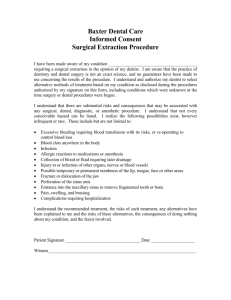Informed Consent for Sinus Augmentation P
advertisement
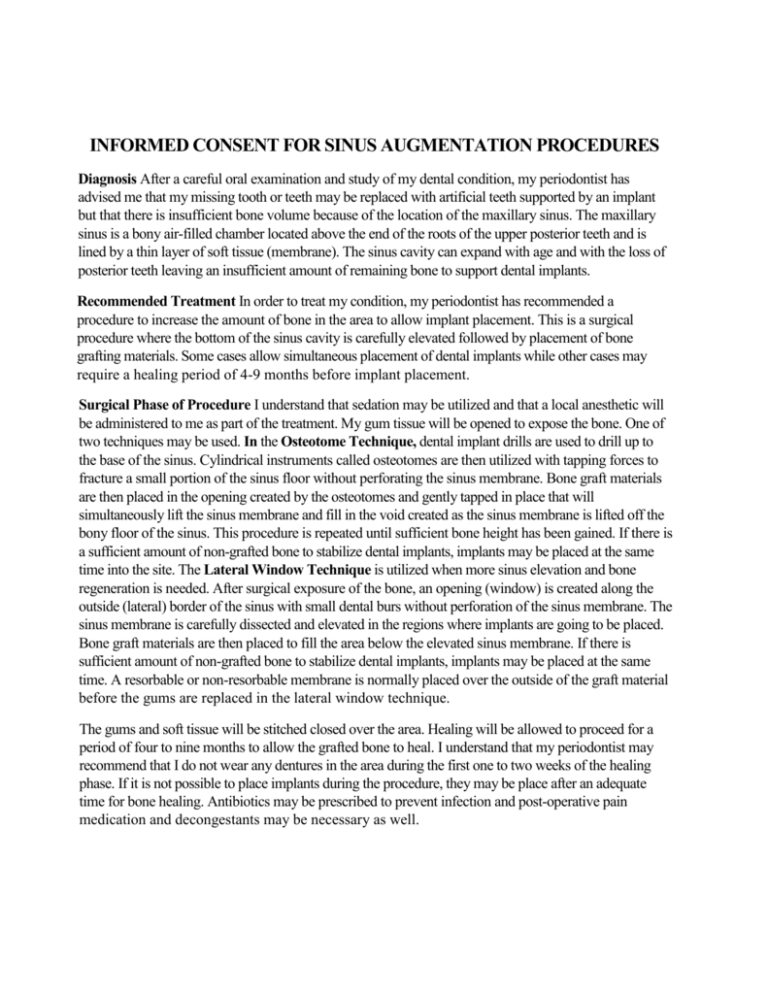
INFORMED CONSENT FOR SINUS AUGMENTATION PROCEDURES Diagnosis After a careful oral examination and study of my dental condition, my periodontist has advised me that my missing tooth or teeth may be replaced with artificial teeth supported by an implant but that there is insufficient bone volume because of the location of the maxillary sinus. The maxillary sinus is a bony air-filled chamber located above the end of the roots of the upper posterior teeth and is lined by a thin layer of soft tissue (membrane). The sinus cavity can expand with age and with the loss of posterior teeth leaving an insufficient amount of remaining bone to support dental implants. Recommended Treatment In order to treat my condition, my periodontist has recommended a procedure to increase the amount of bone in the area to allow implant placement. This is a surgical procedure where the bottom of the sinus cavity is carefully elevated followed by placement of bone grafting materials. Some cases allow simultaneous placement of dental implants while other cases may require a healing period of 4-9 months before implant placement. Surgical Phase of Procedure I understand that sedation may be utilized and that a local anesthetic will be administered to me as part of the treatment. My gum tissue will be opened to expose the bone. One of two techniques may be used. In the Osteotome Technique, dental implant drills are used to drill up to the base of the sinus. Cylindrical instruments called osteotomes are then utilized with tapping forces to fracture a small portion of the sinus floor without perforating the sinus membrane. Bone graft materials are then placed in the opening created by the osteotomes and gently tapped in place that will simultaneously lift the sinus membrane and fill in the void created as the sinus membrane is lifted off the bony floor of the sinus. This procedure is repeated until sufficient bone height has been gained. If there is a sufficient amount of non-grafted bone to stabilize dental implants, implants may be placed at the same time into the site. The Lateral Window Technique is utilized when more sinus elevation and bone regeneration is needed. After surgical exposure of the bone, an opening (window) is created along the outside (lateral) border of the sinus with small dental burs without perforation of the sinus membrane. The sinus membrane is carefully dissected and elevated in the regions where implants are going to be placed. Bone graft materials are then placed to fill the area below the elevated sinus membrane. If there is sufficient amount of non-grafted bone to stabilize dental implants, implants may be placed at the same time. A resorbable or non-resorbable membrane is normally placed over the outside of the graft material before the gums are replaced in the lateral window technique. The gums and soft tissue will be stitched closed over the area. Healing will be allowed to proceed for a period of four to nine months to allow the grafted bone to heal. I understand that my periodontist may recommend that I do not wear any dentures in the area during the first one to two weeks of the healing phase. If it is not possible to place implants during the procedure, they may be place after an adequate time for bone healing. Antibiotics may be prescribed to prevent infection and post-operative pain medication and decongestants may be necessary as well. I further understand that if clinical conditions turn out to be unfavorable for the use of either of these sinus augmentation techniques, my periodontist will make a professional judgment on the management of the situation. Although every effort will be to avoid perforations of the sinus membrane, this is sometimes unavoidable. Small perforations of the membrane are normally inconsequential but larger perforations may necessitate termination of the procedure at that time. These larger tears normally heal without further treatment and additional sinus augmentation procedures can be attempted in one to two months. Expected Benefits The purpose of the sinus augmentation is to create adequate bone in the region to support the placement of dental implants to allow me to have more functional artificial teeth. The implants provide support, anchorage, and retention for these teeth. Principal Risks and Complications I understand that there are inherent risks and complications to all surgical procedures. Because each patient's condition and healing response are unique, long-term success may not occur. I understand that complications may result from the sinus augmentation surgery, drugs, and anesthetics. These complications include, but are not limited to: • post-surgical infection • bleeding (including nasal bleeding) • swelling • pain • , sinus congestion • facial discoloration • jaw joint injuries or associated muscle spasm • transient but on occasion permanent increased tooth looseness • tooth sensitivity to hot, cold, sweet or acidic foods • cracking or bruising of the corners of the mouth • restricted ability to open the mouth for several days or weeks • impact on speech • allergic reactions • injury to teeth • bone fractures • nasal sinus penetrations • delayed healing • accidental swallowing of foreign matter The exact duration of any complications cannot be determined, and they may be irreversible. Alternatives to Suggested Treatment Alternative treatments for missing teeth include no treatment, new removable appliances, and other procedures—depending on the circumstances. However, continued wearing of ill-fitting and loose removable appliances can result in further damage to the bone and soft tissue of my mouth. Necessary Follow-up care and Self-Care I understand that it is important for me to continue to see my dentist or periodontist. Implants, natural teeth and appliances have to be maintained daily in a clean, hygienic manner. Implants and appliances must also be examined periodically and may need to be adjusted. I understand that it is important for me to abide by the specific prescriptions and instructions given by my periodontist. No Warranty or Guarantee I hereby acknowledge that no guarantee, warranty or assurance has been given to me that the proposed treatment will be successful. Due to individual patient differences, a periodontist cannot predict certainty of success. There exists the risk of failure, relapse, additional treatment, or worsening of my present condition, including the possible loss of certain teeth, despite the best of care. . Publication of Records I authorize photos, slides, x-rays or any other viewings of my care and treatment during or after its completion to be used for the advancement of dentistry and for reimbursement purposes. My identity will not be revealed to the general public, however, without my permission. PATIENT CONSENT I have been fully informed of the nature of maxillary sinus augmentation surgery, the procedure to be utilized, the risks and benefits of the surgery, the alternative treatments available, and the necessity for follow-up care and self-care. I have had an opportunity to ask any questions I may have in connection with the treatment and to discuss my concerns with my periodontist. After thorough deliberation, I hereby consent to the performance of sinus augmentation surgery as presented to me during consultation and in the treatment plan presentation as described in this document. If clinical conditions prevent the successful completion of the sinus elevation, I defer to my periodontist's judgment on the surgical management of that situation. I also consent to use of alternative procedures if clinical conditions are found to be unfavorable for the use of the technique that has been described to me. I also give my permission to receive supplemental bone grafts or other types of grafts to build up the ridge of my jaw and thereby to assist in placement, closure and security of any planned dental implants. I CERTIFY THAT I HAVE READ AND FULLY UNDERSTAND THIS DOCUMENT. Date Printed Name of Patient, Signature Parent or Guardian Date Printed Name of Witness Signature of Witness
